The Jpk 1010 is a 32.81ft fractional sloop designed by Jacques Valer and built in carbon fiber or composite by JPK Composites since 2011.
The Jpk 1010 is a light sailboat which is a high performer. It is very stable / stiff and has a low righting capability if capsized. It is best suited as a racing boat. The fuel capacity is originally very small. There is a very short water supply range.
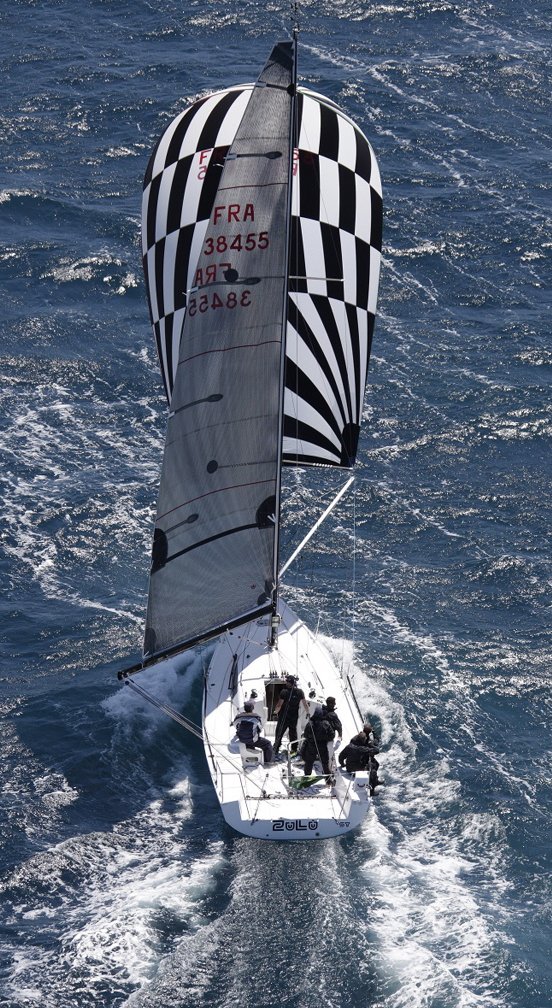

Jpk 1010 for sale elsewhere on the web:

Main features
Login or register to personnalize this screen.
You will be able to pin external links of your choice.

See how Sailboatlab works in video

We help you build your own hydraulic steering system - Lecomble & Schmitt
Accommodations
Builder data, other photos.
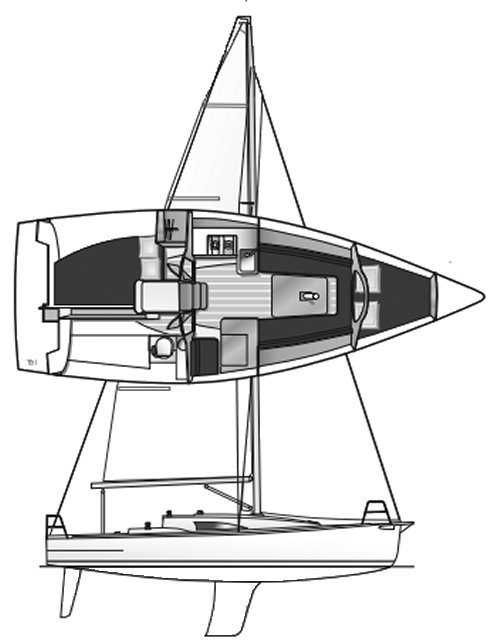
Modal Title
The content of your modal.
Personalize your sailboat data sheet
- Boats for Sale
Boats similar to JPK 1010
Boat not available.
JPK 1010 for sale in Cherbourg France
Cherbourg France
Make & Model
MEASUREMENTS
Description.
JPK 1010's are sought after IRC rocket ships. Always on the podium and ideal for short-handed or fully crewed racing, their racing record speaks for itself.
"Jaasap" is a nicely equipped and presented boat. Lying in Cherbourg and TVA paid, she can be ready in time for your 2020 race campaign. If you like winning, then this boat typifies all the best features of the current breed of successful IRC racing yachts, which are equally good at fast cruising.
Yacht Information
- Boat Name: JAASAP
- Year: 2014
- Builder: JPK Composites
- Designer: Jacques Valer
- Location: Cherbourg
- LOA: 32 ft 8 in / 10.00m
- LWL: 28 ft 7 in / 8.76m
- Beam: 11 ft 1 in / 3.39m
- Draft: 6 ft 5 in / 1.98m
- TCC 2018 : 0,998
- Mât carbone Axxon haut module et tangon carbone
- Safrans de 1080
- Quille droite
- Electronique NKE avec Wifi et 2 Gyrographic
- Speedo girouette HF
- Ordinateur : Shuttle all in one avec Adrena first et cartographie Manche - Atlantique - Irlande
- Materiel de sécurité compatible avec les règles OSR cat 2 (voiles de sécurité comprises)
- Information Additionnelle:
- Bateau bien entretenu et hiverné 2 mois par an à terre. Cadres-banettes dans le carré permettant le matossage et le couchage (voir photos)
- Décoration de coque d'origine sur sticker retirable (gel coat protégé)
GV, génois et solent North 3DL avec taffetas 2014
Spi medium 2018
Spi medium North 2014
Spi lourd North 2014 peu servi
Code 0 Incidences 2017 (sans emmagasineur) peu servi
Spi assymetrique North A5
GV de convoyage (Figaro 2)
- 2018 IRC Rating: 0.998
- High modulus Axxon carbon mast and carbon spinnaker pole
- The twin rudders are the JPK 1080 designed rudders, for extra grip and control
- NKE electronics with wifi and 2 Gyrographic
- Speedo wind vane HF
- Computer: Loaded with Adrena software and Channel-Atlantique-Ireland cartography
- Safety equipment compatible with OSR Cat 2 rules (storm sails included)
- Additional Information:
- Double berth forward, double berth aft
- Boat well maintained and wintered 2 months a year ashore. Banquet frames in the saloon allowing the matossage and sleeping (see photos)
- L-shaped galley with sink + pressurised water
- Original hull decoration on removable sticker (protected gel coat)
Mainsail, Genoa and Solent - North Sails 3DL with taffeta 2014
Spinnaker medium 2018
Spinnaker medium North 2014
North 2014 heavy spinnaker - little used
Code 0 Incidences 2017 (without furler) little used
Asymmetric spinnaker North A5
Delivery Mainsail (Figaro 2)
- Volvo D1 20 18hp
- 2-blade folding propeller
- Fuel capacity: 34 litres
- Water capacity: 80 litres
- Volvo cabin heater - warm air system when the engine is running
- 1 x 75 amp/hr engine battery
- 1 x 105 amp/hr domestic battery
- Tricolour & anchor light on masthead
- Electronics panel
- 220v Shore power system
Please Note
The Company offers the details of this vessel in good faith but cannot guarantee or warrant the accuracy of this information nor warrant the condition of the vessel. A buyer should instruct his agents, or his surveyors, to investigate such details as the buyer desires validated. This vessel is offered subject to prior sale, price change, or withdrawal without notice.
It is not guaranteed that the safety gear listed on the specification comes within the manufacturer's safety guidelines i.e. expiry dates and servicing and is therefore sold as is.
Engine Count
Engine Horse Power
ADDITIONAL INFORMATION
Hull Material
Drive Transmission Description
No of Heads
ABOUT JPK 1010
The JPK 1010 is a 33 feet long that boasts a 11 feet beam. and a draft of 1.98 meters.This 2014 diesel JPK 1010 is powered by a Volvo D1 20, with 18.0 horsepower. The JPK 1010 is made of fiberglass.
SIMILAR LOCATIONS
- JPK in France
- Boats in France
Great choice! Your favorites are temporarily saved for this session. Sign in to save them permanently, access them on any device, and receive relevant alerts.
- Sailboat Guide
Jpk 1010 is a 32 ′ 9 ″ / 10 m monohull sailboat designed by Jacques Valer and built by JPK Composites starting in 2011.

Rig and Sails
Auxilary power, accomodations, calculations.
The theoretical maximum speed that a displacement hull can move efficiently through the water is determined by it's waterline length and displacement. It may be unable to reach this speed if the boat is underpowered or heavily loaded, though it may exceed this speed given enough power. Read more.
Classic hull speed formula:
Hull Speed = 1.34 x √LWL
Max Speed/Length ratio = 8.26 ÷ Displacement/Length ratio .311 Hull Speed = Max Speed/Length ratio x √LWL
Sail Area / Displacement Ratio
A measure of the power of the sails relative to the weight of the boat. The higher the number, the higher the performance, but the harder the boat will be to handle. This ratio is a "non-dimensional" value that facilitates comparisons between boats of different types and sizes. Read more.
SA/D = SA ÷ (D ÷ 64) 2/3
- SA : Sail area in square feet, derived by adding the mainsail area to 100% of the foretriangle area (the lateral area above the deck between the mast and the forestay).
- D : Displacement in pounds.
Ballast / Displacement Ratio
A measure of the stability of a boat's hull that suggests how well a monohull will stand up to its sails. The ballast displacement ratio indicates how much of the weight of a boat is placed for maximum stability against capsizing and is an indicator of stiffness and resistance to capsize.
Ballast / Displacement * 100
Displacement / Length Ratio
A measure of the weight of the boat relative to it's length at the waterline. The higher a boat’s D/L ratio, the more easily it will carry a load and the more comfortable its motion will be. The lower a boat's ratio is, the less power it takes to drive the boat to its nominal hull speed or beyond. Read more.
D/L = (D ÷ 2240) ÷ (0.01 x LWL)³
- D: Displacement of the boat in pounds.
- LWL: Waterline length in feet
Comfort Ratio
This ratio assess how quickly and abruptly a boat’s hull reacts to waves in a significant seaway, these being the elements of a boat’s motion most likely to cause seasickness. Read more.
Comfort ratio = D ÷ (.65 x (.7 LWL + .3 LOA) x Beam 1.33 )
- D: Displacement of the boat in pounds
- LOA: Length overall in feet
- Beam: Width of boat at the widest point in feet
Capsize Screening Formula
This formula attempts to indicate whether a given boat might be too wide and light to readily right itself after being overturned in extreme conditions. Read more.
CSV = Beam ÷ ³√(D / 64)
SA: Mainsail 33m2/355 sq.ft. Genoa 25m2/269 sq.ft. Asymmetric spinnaker 95m2/1023 sq.ft. Symmetric spinnaker 85m2/915 sq.ft.
Embed this page on your own website by copying and pasting this code.
- About Sailboat Guide
©2024 Sea Time Tech, LLC
This site is protected by reCAPTCHA and the Google Privacy Policy and Terms of Service apply.
BoatNews.com
Portrait of a building site / JPK Composites, high performance sailboats born from a fertile architect-builder duo
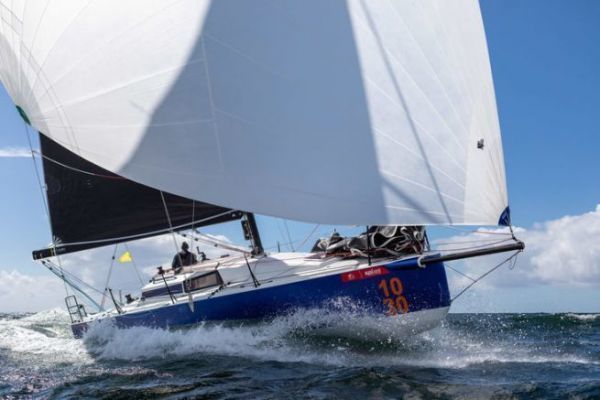
For 20 years, JPK Composites has been building fast, easy-to-handle sailboats for cruising and racing. Here's a look back at the history and development of this Breton shipyard, born of a successful blend of construction know-how and naval design talent.
From funboard shape to cruising racing monohull
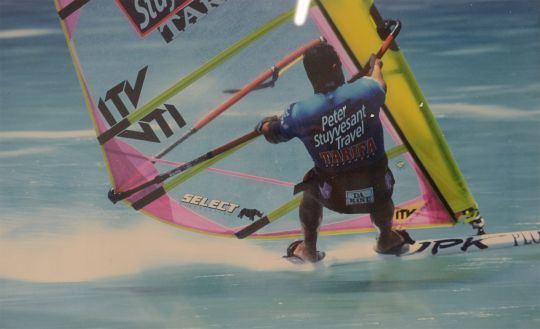
Launched in 1992, JPK Composites was originally a specialist in the manufacture of high-end epoxy sandwich funboards. Founder Jean-Pierre Kelbert drew on his experience as a top-level racer to supply windsurfers during the golden age of funboarding. His knowledge of advanced composites also enables him to build specific parts for ocean racing.
But in the early 2000s, many board manufacturers were relocating their production to Asia to improve profitability. JPK Composites had to reinvent itself, and decided to start producing cruising racing yachts capable of competing on the IRC circuit.
As part of this project, Jean-Pierre Kelbert met Jacques Valer, a merchant navy officer converted to naval architecture .
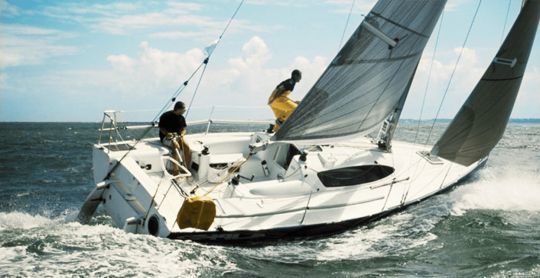
The pair were on the same wavelength, so much so that in 2003, the shipyard launched the JPK 960, a multi-purpose cruising yacht equally at home around three buoys and in offshore races.
Commercial success in a niche market
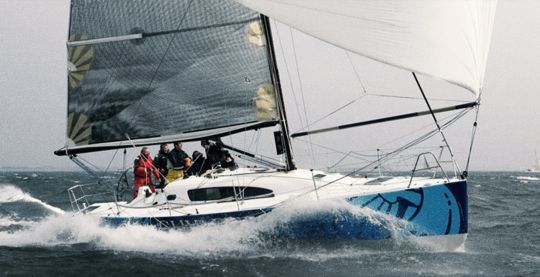
The success of the JPK 960 gives the young shipyard a good reputation. The Kelbert-Valer duo launched the JPK 110, with promising performance, but which suffered a heavy penalty imposed by the IRC rules.
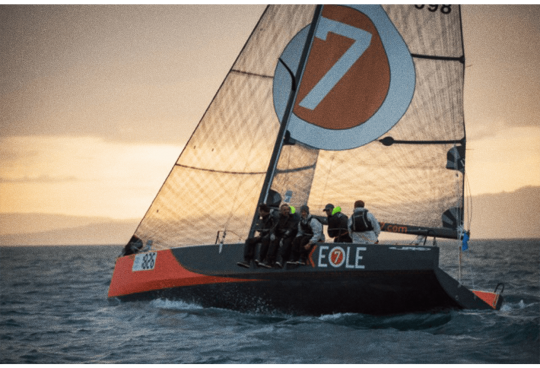
JPK then presents the JPK 998, which competed for the Tour de France à la Voile tender as a replacement for the Mumm 30. Despite outperforming its rivals, the JPK 998 was sidelined in favor of the M34, which went on to enjoy a highly contested career.
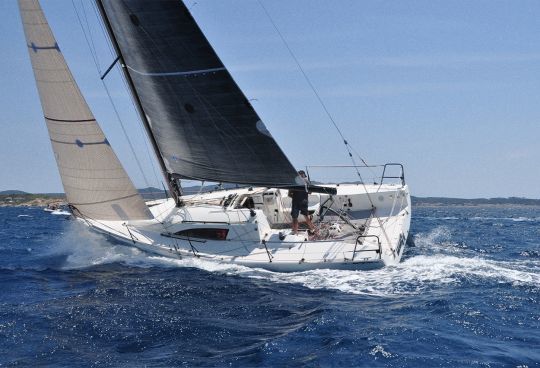
The launch of the JPK 1010 in 2010, future winner of four editions of the Transquadra, a top-level amateur transatlantic race, and the Fastnet 2013, will confirm the success of the builder-architect tandem.
Expanding into fast cruising without abandoning our racing DNA

In 2012, the shipyard demonstrated the versatility of its production by launching the JPK 38 FC, for Fast Cruising. With this model, dedicated to fast cruising, the Breton shipyard demonstrates its know-how by adapting smart, comfortable layouts to a high-performance hull.
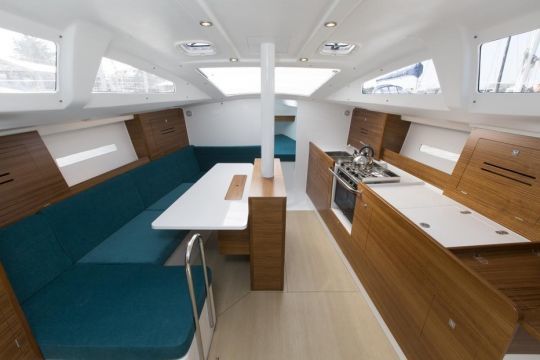
2014 will see the arrival of the JPK 1080, which will once again shake up the IRC circuit. Built for offshore racing, it will win the Transquadra, the Fastnet and the legendary Sydney Hobart.
The 2019 release of the JPK 1030 marks a turning point in design, with a boat typified for double-handed or single-handed ocean racing.
A range of 4 sailboats...and soon a motorboat
In 2023, the shipyard will offer 4 sailboat models:
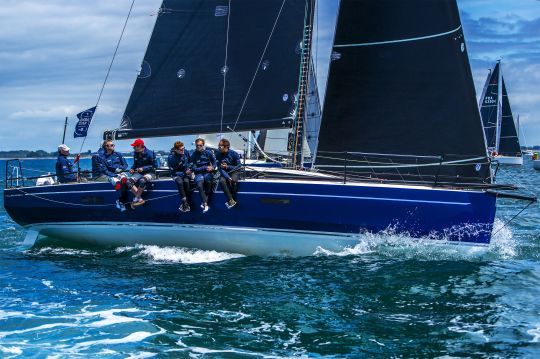
- the JPK 1030 and 1180 are dedicated to a regatta or offshore racing program. Racy and powerful, these two models will soon be joined by the 1085, currently under development.
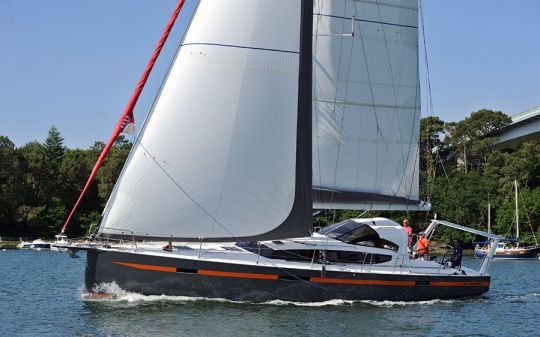
- the JPK 39 FC and 45FC retain the DNA of a fast, powerful sailboat , but with features designed for ocean cruising.
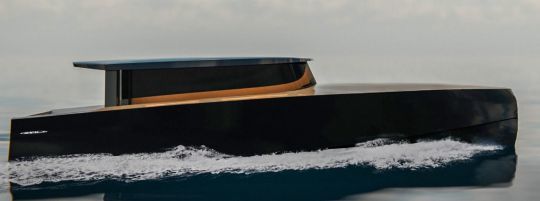
In 2023, this range of sailing yachts will be completed by the launch of the shipyard's first motor yacht, the Nomad 40. Dedicated to coastal cruising and built to the same high quality as the shipyard's sailing yachts , it will be equipped with a small engine to enhance its autonomy.

Recognized expertise in infusion
On a JPK, the hull is infused at the same time as the ribs, to ensure a highly rigid one-piece structure. The shipyard's expertise in infusion is recognized throughout the industry. All stages of production are carried out in-house by a team of enthusiasts, most of whom are sailors.
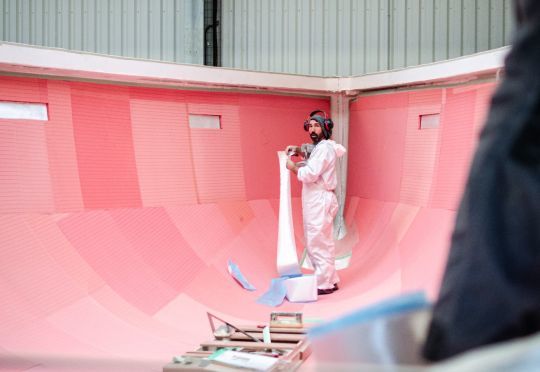
Each unit is made to order, to guarantee the future owner an optimum level of personalization.
The site in figures
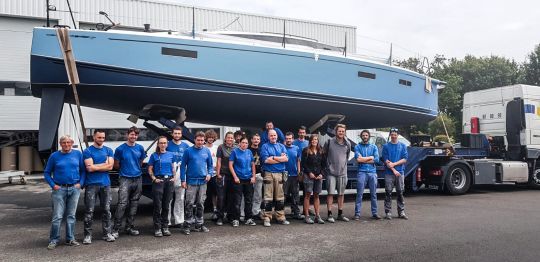
Since its creation, JPK Composites has launched nearly 250 units. Based at Larmor-Plage in Morbihan, the yard employs around 50 people, and has generated sales of 5.2 million euros in 2021.
The production facility occupies a surface area of 4,000 m2, and produces around twenty units each year.
+61 498 441 734 / +61 403 807 726

Credits: Paul Wyeth / Kurt Arrigo JM Liot

THE JPK LEGEND
Happy owners is my goal

Jean Pierre Kelbert is an acclaimed sailor winning two European windsurfer titles in consecutive years. This grass roots understanding of the dynamics of sailing is the platform of the now famous range of IRC winning yachts.
Victories in single and double handed racing has established Jean-Pierre among the legendary French sailors.
Jean Pierre Kelbert’s yachts are now confirmed at the peak of IRC racing, winning all major European and UK regattas with the JPK 10.10’s, JPK 10.80’s and JPK11.80’s.
As Jean Pierre said “happy owners is my goal” which is reflected by the numerous podium results the JPK brand has achieved.
The amazing performance of the JPK 11.80 “Courrier Recommandé” winning IRC overall in the tough and very competitive 2018 Middle Sea race confirms the smiling faces of happy owners.
Jean-Pierre is at the helm of the business with sailing expertise and technical know-how complimented by the iconic naval architect Jacques Valer. This combination has delivered a winning formula for the ever expanding fleet of JPK owners.

The Race to the Start of the 2023 Sydney to Hobart Yacht Race

Setting Sail Towards Sustainability: JPK Pacific's Innovative Approach to Eco-Friendly Boat Building

4 Yachts in the Top 6: A Spectacular Achievement

Speak soon!
Ref : FRMAL334357
Technical sheet
Builder : Jpk composites
Architect : J. VALER
Material : GRP
Length : 10,00 m
keel : Fixed Keel
Draft : 1,98 m
hull : Monohull
Life Raft : Yes
Year : 2010
Beam : 3,39 m
Subtype : Pleasure, Fast
Brand : VOLVO
Shaft : Saildrive
Power Unit. (CV) : 20
Fuel : Diesel
Montage : In Board (IB)
Engine(s) : 1
Double Cabin : 1
Sailor Cabin : 0
WC : Sailor
Limitation of liability : XBOAT presents the details of the boat as supplied to us by the owner. Owners may make errors or changes without notifying us. This information is not contractual and does not bind XBOAT in any way. It cannot be opposed by a visitor or a buyer.
2010 | France FWI
TOFINOU 9.5
2008 | France Atlantic Rochelle
2018 | Italy Sicily
Xboat offers you its expertise and estimates your boat.
Xboat will find you a buyer quickly and at the best price, thanks to its wide network of agents and its powerful computer system.

Home > Our range > JPK 1080
All the optimisations carried out on the JPK 1010 have made it possible to progress each year to achieve the perfect season in 2013: SNIM, spi Ouest France, Giraglia, Tour of the Isle of Wight, Cowes Week, Atlantic Trophy double, RORC Championship, Atlantic Duo and in climax a historic double in the Fastnet won by the tandem Alexis and Pascal Loison.
The JPK 10.80 takes full advantage of all the developments made on the 1010. Jacques Valer, our architect, called the "magician", did not forget any detail of the project to realize a perfectly balanced and optimized "machine" able to win in IRC 2 in all the race formats and whatever the crew configuration.
Loyal to the "spirit of the IRC rule" the boat nevertheless retains a degree of finish and interior equipment consistent with a boat of this size. Unbeatable in racing, bright and stylish on deck and inside, the 10.80 represents the best of our know-how, from a team of technicians and passionate sailors.
Naval architect J. Valer
- LOA 10,80 m
- Displacement 4,8 t
- Volvo engine 30 cv
- Draft 2,20 m
- Genoa 33 m²
- Asy spinnaker 120 m²
- Symetric spinnaker 105 m²
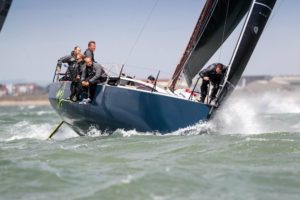
Racing machine
A few months after its launch, the boat has already shown great potential. True to his "magic" style of drawing, Jacques Valer has once again succeeded in the challenge of an extremely competitive hull with a smooth and forgiving behavior and impressive stability.
Results inshore or offshore are the best proof of this.
The 10.80 benefits from the optimisation work carried out on the 1010 with a design that is accurate in terms of performance but tolerant and reliable in terms of sea keeping. It is a "light" and lively IRC that performs well for its size.
The hull is especially optimised to combine high power for performance in breezes and low drag for speed in light airs and open wind performance.
The deck layout has been designed for efficiency and comfort, with a very well designed steering position (coamings angled forward).
All the fittings are designed for maximum efficiency and versatility between full crew and single/double crew operation.
Tired of getting sprayed and stupidly chilled on watch, we designed a sliding bubble to protect the companionway.
Sitting on the companionway, it offers a perfect watch from the wind and spray with a translucent panel to check the sails and the course. In strong winds, upwind, it perfectly protects the descent from the spray and secures the instruments on the chart table.
When the conditions are right again, you slide it forward and the companionway is back to normal. On crewed inshore races, it can be dismantled in 2 minutes and the genoa inhaulers can be swapped in the middle.
Similarly, the floors are covered with a translucent anti-slip material and the handrails are placed at the "natural" gripping points.
Inside, everything has been thought out for the quality of life while sailing.
The open roof allows you to rest on the port and starboard side with a panoramic view of the outside. Combined with the frame bunks for stacking or sleeping for the crew during the race and a "wet" area for storing sails and gear, the concept responds to the pleasure of cruising by its simplicity, its modernity and its clarity.
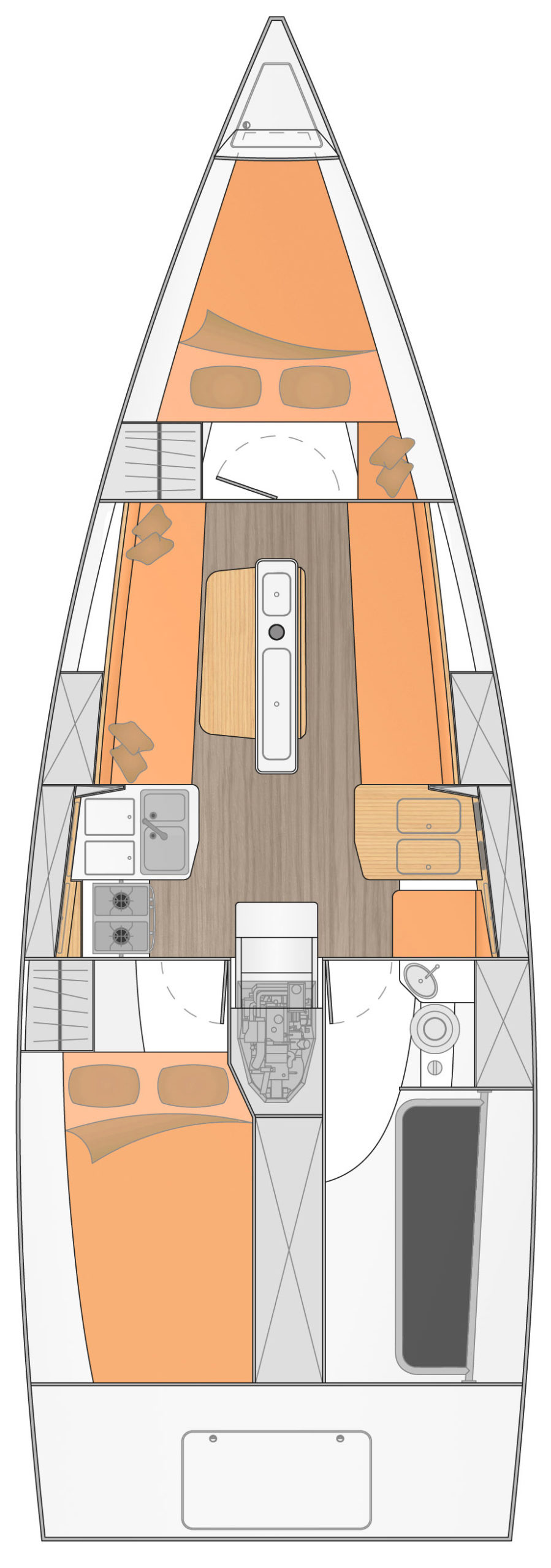
Our lastest news featuring the JPK 1080
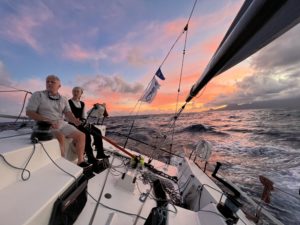
Caribbean 600 : Victoire du JPK 1080 « In Theory » !
« In théory » n’est autre que l’ancien « Léon » 2eme en solo de la TQS 2018 . Peter Mac Whinnie vit à New York et avait racheté
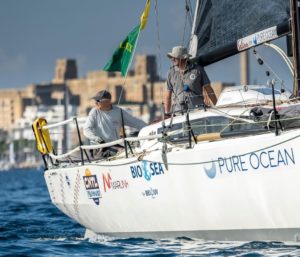
Victoire en double à la Middle Sea Race pour Solenn for Pure Ocean !
Un grand bravo à Ludovic Gerard pour cette victoire sur la middle sea race. Une saison 2022 incroyable pour Ludo avec un carton plein en
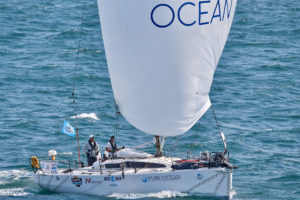
Le récit de course de Ludovic Gérard, vainqueur de la Drheam Cup
Se tenant tous les deux ans en alternance avec le Fastnet, la Drheam Cup a vu cette année un record de participation avec 125 bateaux

+33 2 97 83 89 07
1, bv. Lavoisier – ZA de Kerhoas 56260 Larmor-Plage
© 2022 JPK Composites – All rights reserved – TERMS OF USE & CREDITS – SITEMAP
Yachting World
- Digital Edition

JPK 45 boat test: A performance cruiser that provides memorable enjoyment
- Toby Hodges
- September 26, 2019
This quirky French cruiser has the soul of a race yacht and is full of innovations. Toby Hodges sails the JPK 45
Product Overview
Manufacturer:, price as reviewed:.
Pascal and Alexis Loison entered the sailing history books in 2013 for an extraordinary achievement. Not only did the father-and-son team win the Rolex Fastnet Race overall, but they did so double-handed, racing against more than 300 fully crewed yachts. They were sailing a JPK 1010 named Night & Day .
Any racing sailor who hadn’t heard of JPK before then will now know all about these IRC performers, which are built in Brest. In the last few years JPK yachts, and in particular the 1010 and 1080 models, have continued to dominate just about every coastal and offshore race in British and French waters.
They are competent in most conditions, whether sailed short-handed or fully crewed. Now the JPK 45 is the yard’s brilliant take on a cruising yacht.

The optional composite frame is strong enough to stand on, to dive off and to lift and stow a dinghy. It also provides a useful support and position for carrying solar panels and antennae
Cruising sailors may be less familiar with this brand and builder. The JPK 45, one of the 2017 European Yacht of the Year nominees, is only the yard’s second cruising model. We tested number one of this purposeful looking design, which was commissioned by a group of three French owners for global sailing.
We sailed her out of La Rochelle with Monsieur JPK himself, Jean-Pierre Kelbert, just after the boat had returned from a ten-month, 12,000-mile transatlantic circuit. And what we found on board left me in no doubt that the JPK brand’s reputation for building cruising yachts is only going to grow from here.
Hitting it off
It is pretty rare for me to step aboard a new boat and feel totally confident and at ease with its ability. The first word written in my notebook during our sea trial was simply “YES!!” And this was despite what could otherwise have been quite a nerve-racking experience.
Article continues below…

JPK 1030 test: The intuitive French flier that’s easy for couples to control
Pip Hare feels right at home on the JPK 1030 – a quick, no-nonsense boat that’s ideal for short-handers

Jeanneau Sun Fast 3300 review: The pocket rocket inspired by foiling IMOCAs
Jeanneau’s latest Sun Fast is a whole bundle of fun, as Pip Hare discovered on a full test of the…
Having just boarded the JPK 45 from a RIB off La Rochelle, Kelbert handed me the helm and set about unfurling the headsail. All around us, however, was a fleet of more than 80 Mini 6.50m race boats, together with a hoard of spectator vessels.
The Minis were racing under spinnaker towards the finish line, but I quickly realised there was little cause for concern. Both the direct control of the JPK 45 and the calm confidence of Kelbert himself put me instantly at ease. With the 110 per cent genoa unfurled we were up to speed in no time. The wind played ball too, picking up to 10 knots – the most we had seen all weekend.
The Dacron sails looked exactly as you would expect from a suit that had done an Atlantic circuit, having lost a little shape. Not that this seemed to affect the performance of the JPK 45. She maintained a handsome 8 knots in 10 knots true at 31-33 ° to the apparent wind (and 7.3 knots in 7.1 knots true).

Toby at the helm of the JPK 45
And it felt wonderful behind the wheels. The helm is relatively neutral, as can be expected from a modern performance yacht with twin rudders, but is light and responsive to the touch. She is a slippery, stiff boat, too.
You can feel the soul of a race boat within her lightweight construction. The JPK 45 has more curve in the bilge turn compared to JPK’s racing models and more volume forward. But beamy aft sections, long, hard hull chines and a high concentration of ballast low down in the fin keel provide oodles of righting moment.
A twin headsail set-up, with genoa and staysail furlers controlled from the cockpit, is a useful cruising solution. It allows you to easily adapt the sailplan to the conditions. Short-tacking through the congested waters proved a little slow under genoa, however. Although there is good clearance between the headsails, you still need to pull the genoa through manually from the foredeck if trying to tack without furling.

This helped produce figures of high 7s in 8.5 knots at 60 ° apparent – and allowed us still to match or exceed the true wind speed when it dropped to 6 knots.
With the kite doused and stowed in the sock, Kelbert was back on deck, hoisting a gennaker on a furler for the long fetch back to La Rochelle. This is a useful sail for a cruiser’s arsenal too, which Kelbert says can be used from 60 ° to the true wind right up to 120 ° .
We typically clocked 7 knots in 8 knots true, close reaching at 35-40 ° to the apparent wind. It was the type of sailing you never want to end. It is gratifying to be able to tune a cruising yacht easily and to be able to take advantage of light breeze conditions so well.
Mini skippers waved to Kelbert as we threaded our way through the fleet, which by now was queuing to get into the old port. We furled the gennaker in the channel and gybed into the marina as if we were on a sportsboat.
As the main dropped into a stackpack, I started the engine and eased the JPK 45 into a tight pontoon berth. To do this on a new boat in a seriously congested channel and marina is a testament to the confidence this boat instils.

The inboard winch and clutch layout with rope bin stowage is superb
Deck layout
The winch and clutch layout is superb and particularly well suited to short-handed sailing. The two Harken Performa winches each side are located inboard, within easy reach of the wheels and in a position where it is easy to stand and grind.
It continues to amaze me that so few cruising yachts have primaries mounted inboard like this. Standing over a winch in the cockpit is so much safer than crouching over the coaming. It can also negate the need for powered winches at this size as you can use your body more efficiently when working the handle.
The JPK 45 has eight clutches each side through which the running rigging and sheets are led to the winches. Even the backstay and runners feed to these winches (although spinnaker halyards use a mast base winch), while large boxes directly below swallow the tail ends neatly. The only negative point of the JPK 45’s clutch and winch set-up is the friction caused by the 90 ° turning blocks for the headsail sheets and furling lines.

An optional rigid doghouse provides excellent cockpit protection and keeps the mainsheet clear. The forward window panel opens for ventilation
Keeping the sailing systems in a compact area aft, near the wheels, also helps maximise cockpit space. The rigid doghouse (which is optional) provides all the protection you could wish for in the cockpit without needing to rely on a high coachroof or coamings. The benches are long enough to seat four on each side of the large fixed table, and flat coamings allow a particularly easy step out to the side decks.
The doghouse also helps keep the mainsheet out of the cockpit. Instead of a traveller, a bridle attached to the roof is a practical cruising compromise. The blocks attach to the boom using simple lashing strops and the sheet leads forward to the mast before returning aft to the winches.
The JPK 45 has a safe deck. Non-slip grip is incorporated into the whole deck, a toerail is moulded in and there is a handrail on the foredeck. The swim ladder is a clever design as it doubles to form the central section of the aft guardrail when in raised mode.

A deep chain locker includes space for housing fenders and warps. The composite bowsprit carries the anchor rollers (one or two anchors). Note the foredeck hand rails too
Beneath the aft helm seats is a large gas locker to port and a liferaft locker to starboard. The latter has an aft-facing flap that operates via a pulley hidden under the foot brace. A large central locker aft also provides access to the JP3 Vectran steering gear.
Why no frills works
Modern French performance cruiser builders, such as Pogo, Django and JPK, keep their interiors lightweight, simple yet practical. But they are in danger of feeling spartan. The interior of the JPK 45 is just the right side of utilitarian for an offshore performance cruiser – basic maybe, but seaworthy certainly.
The light, bright and practical interior is finished in bleached oak veneer. After 12,000 miles of non-stop hard use by seven to eight sailors, it still looked new down below (although Kelbert admitted it needed a good scrub after its recent return). The waterproof vinyl used on the soles and hull linings is a smart, wipe-clean solution that is vacuum-glued on for a simple light finish.
The test boat had three double cabins, a Pullman and a single heads. While the central galley/saloon section of the layout cannot be altered, there is the option to remove the Pullman in favour of a second heads. One of the aft cabins can also be replaced with a workshop/utility cabin.
The large, near vertical coachroof windows help provide plenty of natural light without glare. The saloon is slightly raised to allow room for tanks to be kept as central and low as possible below, and it shares the beam with the longitudinal galley.
The fixed table can seat six. A central unit around the mast base, which resembles a keel box (there is an option for a lifting keel), provides both stowage in drawers and support when working at the galley on starboard tack. Otherwise there is little usable stowage space in the saloon, but plenty under the berths.

The modern interior is simple, practical and light – both in terms of weight and natural illumination
The layout is less conventional forward of the mast where there is a chest of drawers-cum-workdesk unit to starboard and a Pullman cabin to port. The forward cabin is simple, with ample natural light, 6ft 1in headroom and a large, high double berth with roomy stowage below.
The compromise to the layout of the test boat is that there is only one heads (which is relatively compact). But this still has the practical inclusion of a large wet-hanging locker within the shower area.
The secret to JPK ’ s success?
What makes JPK’s race boats win so consistently and its cruising yachts slip along so well? Smart design and resin-infused foam sandwich construction. The whole hull is infused in one shot for rigidity.
JPK uses a labour intensive method: virtually all the parts that go into the boat are moulded and all the interior furniture is foam sandwich, laminated into the hull to contribute to the structure. But this method is expensive – the JPK 45 is around twice the price of a series production Beneteau/Hanse of similar size and more comparable in price to an X-Yacht or Solaris.

Light floods the modest longitudinal galley. Note the French racing-style bucket seat (far right) and large chart table
Jacques Valer, who has designed all the JPKs, calculates the weight of every single component that goes into the boat. There is only around 200kg of wood in total on the JPK 45 – even the doors have foam inside.
The JPK 45 is designed to be efficient to sail upwind – and strong. It is reinforced in key areas with high-density foam, which Kelbert likes using as, unlike balsa, it accepts some water and deformation. In fact, the build technique sounds like a similar approach to that of Pogo.
But Kelbert says JPK uses more lead ballast. “JPKs are not as fast in a crosswind, but are faster and more comfortable at other angles,” he says. “If the wind is on the nose, it has to be comfortable.”
From windsurfers to Fastnet winners
Jean-Pierre Kelbert (pictured right), who founded JPK, is a former professional windsurfer and European champion in 1988 and 1989. He founded his own board manufacturing company in 1992, but by the late 1990s windsurfer production had moved to Thailand so he started moulding parts for other shipyards.
Kelbert is also a successful short-handed sailor and it was while racing his JOD35 one-design in 2003 that he saw (and lost to) his first Jacques Valer design. He asked Valer to design a 960, which quickly found success (a JPK 960 won its class in the 2007 Rolex Fastnet Race).
But it was the launch of the 1010 in 2010 that really put JPK on the racing yacht map. Together with the subsequent 1080 (2014), the 1010 ‘has won everything,’ says Kelbert – referring to IRC crewed races, double-handed, the transatlantic Transquadra etc. “The 2013 Fasnet Race win created a lot of international recognition – since then we’ve always been full of orders.”
Kelbert says he still tries to train as much as he can, including lots of double-handed racing in Brittany. “It’s because I practise a lot that I know where everything should go on deck and know the height everything should be.”
For the JPK 45 cruising yacht design, Kelbert was thinking of the boat he’s always wanted to have. “I love racing but equally want to spend time cruising with my family. It’s all about having fun – maximum pleasure.”

A boat can be all about the feeling it gives you. And the enjoyment the JPK 45 gave me on the helm is a memory that stayed with me. The proven record of Kelbert’s boats and his faith in their build quality combines to put you instantly at ease. The JPK 45 is not your typical performance cruiser. She is fast, stiff and seaworthy, but she looks more like a workboat for speedy ocean cruising. The aesthetics, inside and out, will be too stark for many. The doghouse is an option, but one you would surely take unless prioritising looks over comfort. So this is a niche yacht for those who want to get places at a good pace and actively enjoy sailing while doing so. By the time you read this, the boat tested will be on her way to Brazil and then on into the Pacific. The JPK 45 is a clever culmination of Valer’s slippery designs and the yard’s weight-obsessive builds. It has a layout born of thousands of short-handed offshore sailing miles, which makes it as practical and as enjoyable to sail and trim as possible. I predict that the first seven owners who have already ordered this boat will log minimal engine hours – this yacht is one that just makes you want to keep sailing.
Sailboat specifications
- Last update: 25th March 2020
JPK 1080's main features
- 2015: European Yacht of the Year: Performance Cruiser
JPK 1080's main dimensions
Jpk 1080's rig and sails, jpk 1080's performances, jpk 1080's auxiliary engine, jpk 1080's accommodations and layout, jpk 1080's saloon, jpk 1080's fore cabin, jpk 1080's aft cabin.

Similar sailboats that may interest you:

IMAGES
VIDEO
COMMENTS
JPK 1010. Save to Favorites . Beta Marine. BOTH. US IMPERIAL. METRIC. Sailboat Specifications Definitions Hull Type: Fin w/bulb & dual rudders ... Like the LWL, it will vary with the weights of fuel, water, stores and equipment. A boat's actual draft is usually somewhat more than the original designed or advertised draft. For boats with ...
IRC Racing. In 2003, JPK 960 revolutionised the race/ cruise concept combining outstanding marine performance and pure comfort. Winner of 2 Transquadra races and several Atlantic Trophies, the record-breaking JPK 960 remains unchallenged in its category. Building on this winning concept, the JPK 1010 was conceived specifically for cruising.
JPK 1010 Sailboat specifications. Last update: 13rd March 2020. The JPK 1010 is a 32'10" (10m) racer-cruiser sailboat designed by Jacques Valer (France). She is built since 2010 by JPK (France). JPK 1010's main features. Model. JPK 1010. Hull type. Monohull. Category.
The water ballast on the JPK 1030 uses a no-nonsense system, employing a central scoop, with large diameter transfer pipe, and gate valves which can be operated from the cockpit. Filling takes two ...
The Jpk 1010 is a 32.81ft fractional sloop designed by Jacques Valer and built in carbon fiber or composite by JPK Composites since 2011. The Jpk 1010 is a light sailboat which is a high performer. It is very stable / stiff and has a low righting capability if capsized. It is best suited as a racing boat. The fuel capacity is originally very small.
The JPK 1010 is a 33 feet long that boasts a 11 feet beam. and a draft of 1.98 meters.This 2014 diesel JPK 1010 is powered by a Volvo D1 20, with 18.0 horsepower. The JPK 1010 is made of fiberglass.
Jpk 1010 is a 32′ 9″ / 10 m monohull sailboat designed by Jacques Valer and built by JPK Composites starting in 2011. Sailboat Guide ... The lower a boat's ratio is, the less power it takes to drive the boat to its nominal hull speed or beyond. Read more. Formula. D/L = (D ÷ 2240) ÷ (0.01 x LWL)³ D: Displacement of the boat in pounds ...
The JPK 1010 . The launch of the JPK 1010 in 2010, future winner of four editions of the Transquadra, a top-level amateur transatlantic race, ... In 2023, the shipyard will offer 4 sailboat models: The JPK 1180 . the JPK 1030 and 1180 are dedicated to a regatta or offshore racing program. Racy and powerful, these two models will soon be joined ...
The JPK 39 FC is an ultra fast and versatile boat, with bright spaces and many comfort features. JPK 45 FC. A well-balanced hull, a "strong box" construction, reliable peripheral equipment: this is the successful recipe of the JPK 45 FC. ... The JPK 1010 today has the most impressive prize list of the shipyard, with in particular the masterly ...
JPK 960 remains unchallenged in its category. Building on this winning concept, the JPK 1010 was conceived specifically for cruising. It's larger hull and optimised design meet all the latest IRC specifications. Perfectly ballasted, the 1010 remains stable and efficient in all conditions and demonstrates exceptionnel handling qualities.
JPK yachts are versatile, affordable and competitive. Get your winning yacht today. Building the most successful IRC racing yachts (like the JPK 11.80) for Asia Pacific. JPK yachts are versatile, affordable and competitive. Get your winning yacht today. ... Boat Listings. Contact. More. 234864503_2791460171152332_3695074188771022995_n ...
Used 2011 JPK Composites 1010 for sale is located in Guerlédan ( Brittany, France ). This vessel was designed and built by the JPK shipyard in 2011. Key features 2011 JPK Composites 1010: length 10 meters, beam 3.39 meters and boat displacement 3,700 kilograms. engine: engine hours - 205 hours. With a fuel tank capacity of 35 liters, the 2011 ...
JPK. JPK is a yacht builder that currently has 4 yachts for sale on YachtWorld, including 1 new vessels and 3 used yachts, listed by experienced yacht brokers and boat dealerships mainly in the following countries: Australia, Spain, France and United Kingdom. Models currently listed on YachtWorld differ in size and length from 33 feet to 39 feet.
The JPK 1010, JPK 38 and JPK 1080 embody the JPK shipyard's constant quest for excellence and performance, as it continues to write its legend in the world of sailing. These yachts are the fruit of exceptional know-how and bear witness to JPK's ongoing commitment to innovation and quality.
Designed as a continuation of the very good 960, and also signed Jacques Valer, the 1010 has a finer flotation in the middle and wider and taut in the rear forms. We finds the essential evolutionary chine supposed to combine finesse of flotation and good support when heeling. From the outset, the project aimed at a dual program wide/three buoys and wanted a boat relatively light and powerful ...
The JPK 1030 is the latest in a line of champions, with an early planing, powerful reaching and ease at all speeds. JPK 1085 ... JPK 39 FC. The JPK 39 FC is an ultra fast and versatile boat, with bright spaces and many comfort features. JPK 45 FC. A well-balanced hull, a "strong box" construction, reliable peripheral equipment: this is the ...
The JPK 1030 is therefore relatively narrow, with very full forward sections and a smaller hull cavity for a more tensioned hull slope. When heeling, the hull is also well tensioned to favour heeled boat planning. The 300 litre ballast tanks compensate for the rather light straight keel. They are useful starting from 10/12 knots of wind upwind ...
The JPK 10.80 takes full advantage of all the developments made on the 1010. Jacques Valer, our architect, called the "magician", did not forget any detail of the project to realize a perfectly balanced and optimized "machine" able to win in IRC 2 in all the race formats and whatever the crew configuration. Loyal to the "spirit of the IRC rule ...
Sailboat specifications. Last update: 13rd March 2020. The JPK 110 is a 35'10" (10.9m) racer-cruiser sailboat designed by Jacques Valer (France). She was built since 2006 (and now discontinued) by JPK (France).
JPK 45 boat test: A performance cruiser that provides memorable enjoyment. Toby Hodges; ... But it was the launch of the 1010 in 2010 that really put JPK on the racing yacht map. Together with the ...
Sailboat specifications. Last update: 25th March 2020. The JPK 1080 is a 35'5" (10.8m) racer-cruiser sailboat designed by Jacques Valer (France). She is built since 2014 by JPK (France). She has been awarded " 2015 - European Yacht of the Year: Performance Cruiser ".